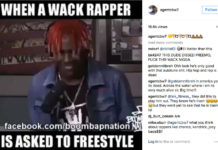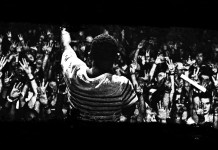In Development
Noisemaker Media started in 2002 largely as an outlet for Carranceja to pursue his creative endeavors in music. “I just wanted to create a business to put my music out there,” he reminisces. “Eventually film. I didn’t really plan on getting back into film anytime soon.”
In the 1990s, Carranceja was heavily involved in the tuntablism and DJ scenes, as well as music production. Being a fan of action sports, Carranceja filmed a series of rollerblade videos in 1996-97. “I wasn’t really thinking about music videos back then neither,” he remembers. “I was thinking, ‘Oh, I’m gonna make a film.’ Me and my crew and pretty much everybody in New York skated together. So we started putting together skate videos. That’s how I got into film school.”
But even while he pursued a film degree, he still concentrated on DJing and music production, because that was where the money was. Filmmaking was in the background, mainly because music had become so lucrative.
Only after he ran into a friend of his did he start filming again. in 2008, Christie Z-Pabon, a DMC USA executive, asked Carranceja to film some DMC events, and from there, things began picking up. Carranceja began researching the technology of making videos, realizing that the pace of advancement had been so great, things he would never have been able to do were now feasible, and at a fraction of the cost.
(Not) Sticking To The Script
Carranceja describes his work as ‘visually dynamic’ with a specific framework. Film school gave him the set of “rules” that he promptly broke.
“I do cinematography and I’m an editor. Maybe I’m not the most conceptual director yet, but I like the camera to be at the forefront. I’m definitely interested in telling stories in the future, but right now I’m in this mode where I really want to be visually dynamic. There was a trend when music videos had a low quality aesthetic to it, and it was sort of accepted. I was like, ‘Wait a second, that’s sort of the reverse training about what production is about.’”
Carranceja believes that new artists should use caution when trying to tell narratives in music videos.
“I like the M.I.A. video for “Born Free,” he states. “That has a narrative, but it’s specifically designed for that. You could do narratives, but you can’t apply music video performances with narratives. It takes away from the artist.”

He explains, “You kind of convolute the video with this unnecessary storyline. It’s either you tell a narrative, or you sell the artist. You can have the narrative sell the artist, or you can have the artist sell himself. You can add elements of a storyline, but not necessarily tell a story.”
Frequent collaborator Jesse Abraham is brought up as an example of what Carranceja does with artists.
“With Jesse Abraham’s video for ‘Spiderman on Vitamins,’ it had a theme to it. There was depth and presentation, but we really didn’t tell a story. He wanted to do something autobiographical and I was like, ‘that’s too much.’ You can’t really tell a story like that at this point in your career. You need to really to continue to sell yourself and put yourself at the forefront as an artist. With these artists, I try to create visually dynamic pieces with a specific framework, that sells them.”
Working closely with the artist helps Carranceja determine what the artist is looking for and how best to meet that artist’s vision. He then takes the artists ideas, however grand, and creates his own framework around it.
If it’s not going to work financially, Carranceja is also realistic with the artist. “If you don’t have $15,000 you don’t have $15,000. You can’t make a $15,000 video on the strength of $1,500.”
Carranceja’s policy has always been one of honesty and integrity, he’s not in the business of selling dreams. Carranceja states that some artists just haven’t reached that level where they can afford to spend tens of thousands on a music video to promote their album.
“That’s why I prefer to do package projects for them, where we could time a specific roll out. I’m not really that great at marketing,” he confides, “But I know if you have this amount of content, you have to see these things as assets. You need to figure how to roll these things out in a timely manner where you could create some kind of momentum and continue to build. You have to use these things as marketing tools.”
Carranceja goes on to clarify. “I’ve encountered A&Rs where they were like, ‘We have five videos, let’s drop it out in five weeks.’ I’m like, ‘It took us like more than five weeks to shoot that! That’s silly.’ Time your releases, be smart about it.”
This creates some laughter in the room – those nearby know the anecdote holds true – as many artists continue to flood the market with content, doing little to stand out with any one song or video.





![The Underachievers – Crescendo [VIDEO]](https://www.birthplacemag.com/wp-content/uploads/2017/08/hqdefault-2-218x150.jpg)


![Fat Joe & Remy Ma ft. The-Dream – Heartbreak [VIDEO] Fat Joe Remy Ma The Dream - Heartbreak Video](https://www.birthplacemag.com/wp-content/uploads/2017/05/fat-joe-remy-ma-218x150.jpg)
![JSWISS featuring Chandanie – LML [VIDEO] JSWISS featuring Chandanie - LML [VIDEO]](https://www.birthplacemag.com/wp-content/uploads/2017/05/JSWISS-218x150.jpg)

![Akinyemi Ends Summer With “Summers” EP Release Show [9-17-17] Akinyemi 'Summers' EP release show at Brooklyn Bazaar](https://www.birthplacemag.com/wp-content/uploads/2017/09/summers-featured-218x150.jpg)
![4th Annual NYC VS EVERYBODY Yacht Party [9/16/17] #VSYacht 4th annual NYC VS Everybody Yacht Party#VSYacht](https://www.birthplacemag.com/wp-content/uploads/2017/09/vsyacht-218x150.jpg)






